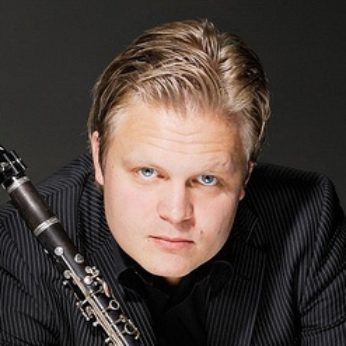Composer: Wolfgang Amadeus Mozart (b. 1756 - d. 1791)
Performance date: 04/07/2012
Venue: Bantry Library
Composition Year: 1784
Duration: 00:25:14
Recording Engineer: Anton Timoney, RTÉ lyric fm
Instrumentation Category:Piano Quartet/Piano Quintet
Instrumentation Other: ob, cl, bn, hn, pf
Artists:
Ivan Podyomov -
[oboe]
Christoffer Sundqvist -
[clarinet]
Peter Whelan -
[bassoon]
Hervé Joulain -
[horn]
Julius Drake -
[piano]

This Quintet is one of the most joyous works of music ever penned.
Mozart himself, writing two months after its composition, described it as the best thing I have ever written
in my life. In the spring of 1784 Mozart was riding an incredible high of
popularity. Taking part in twenty-two concert appearances in the space of a
month many of them devoted to new works, such as the two wonderful piano
concertos K450 & K451. The subscribers to his concerts were the cream of
Viennese society and Mozart in his triple role as impresario, performer and
composer was over the moon. But we must always remember the fickleness of the
Viennese for only five years later Baron von Swieten was the only subscriber to
Mozart’s proposed concert series in 1789.
One of the fashionable developments of
the 1780’s had been the Harmonie or wind-band, often sextets or octets, which
were hired to provide rich households with so-called Tafelmusik, just as in the last
Act of Don Giovanni. The
music for these occasions was often arrangements of popular opera melodies and,
naturally, it meant that the Austrian capital boasted many fine wind players,
which is reflected not only in Mozart’s wind serenades but also in the scoring
of his piano concertos. All this woodwind activity is reflected in Mozart’s
striking technical skill in writing for winds, where he knows to perfection
exactly how each instrument lies.
This Quintet has distinction of being
on first page of Mozart’s Catalogue
of all my Works that he began
in February 1784, along with the four Piano Concertos K449, 450, 451 & 453.
Each entry is numbered with a title, date, orchestration and the first two or
three bars of music.
The majestic Largo
that opens the work immediately presents all the wind instrument both
individually and as tutti. Within his unusual group of instruments Mozart uses
every opportunity to explore the differences in sonority and to create his
glorious kaleidoscope of effects. The main Allegro is in the usual form of
exposition, development and recapitulation, but the interest is primarily in
the extraordinary way in which the instruments are both given their individual
solo spots and combined with the other. The Larghetto achieves a form of such
jewelled perfection that we can instantly understand Mozart’s pride in his
creation, each instrument including the piano is given absolutely equal status.
The final Rondo is more reminiscent of the piano concertos with the novelty
that all five instruments get their cadenza – entering one by one, oboe,
clarinet, horn, bassoon and the piano – thus confirming their collective status
as soloists.
Copyright © 2024 West Cork Music. All rights reserved.
Designed and developed by Matrix Internet